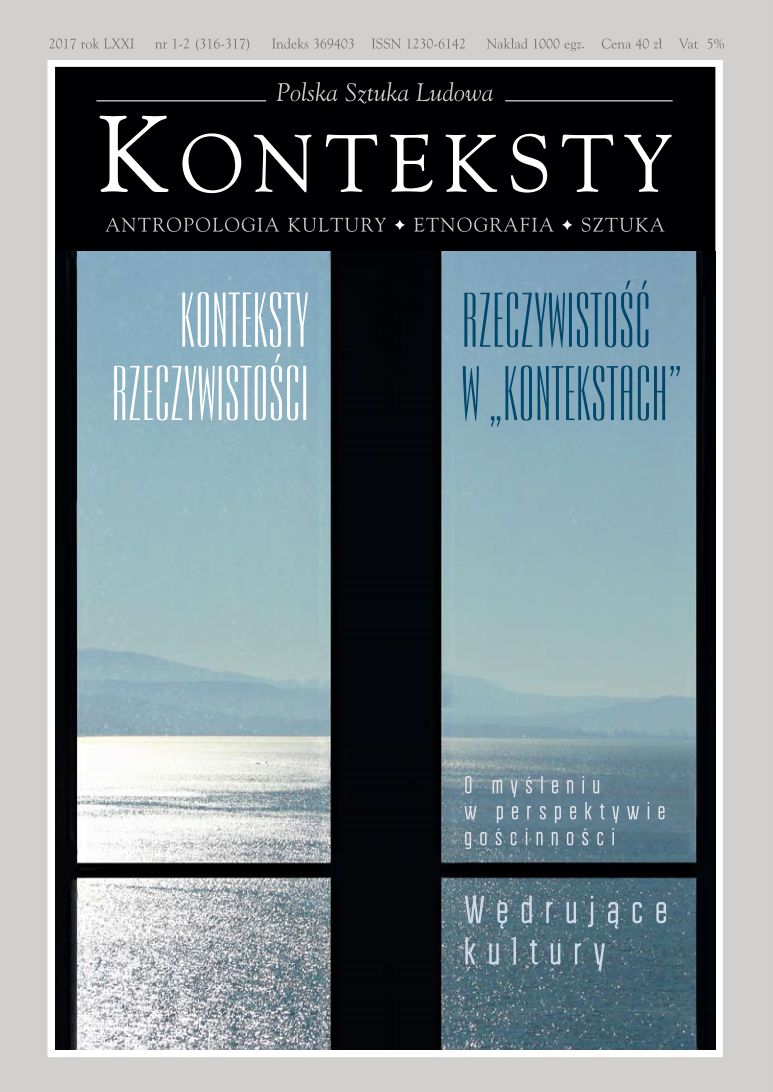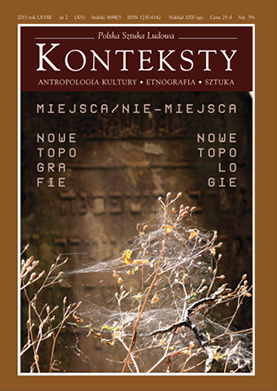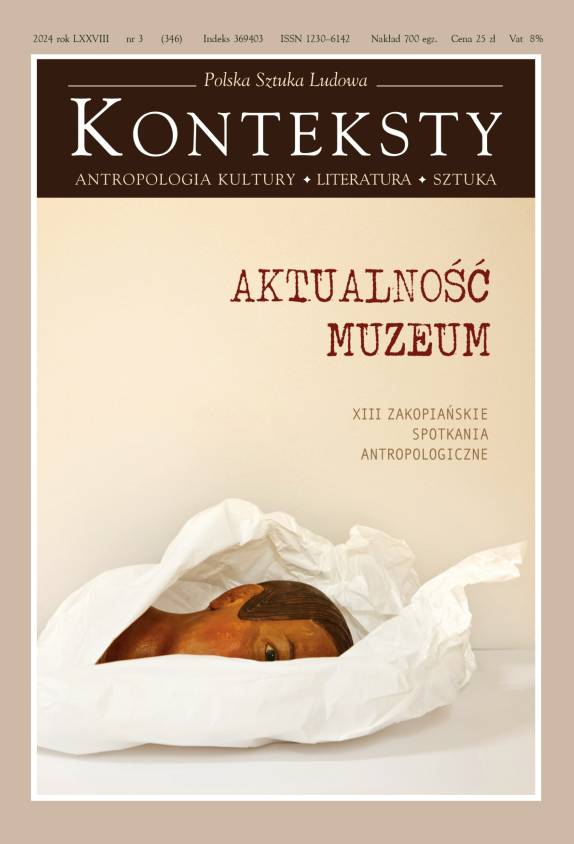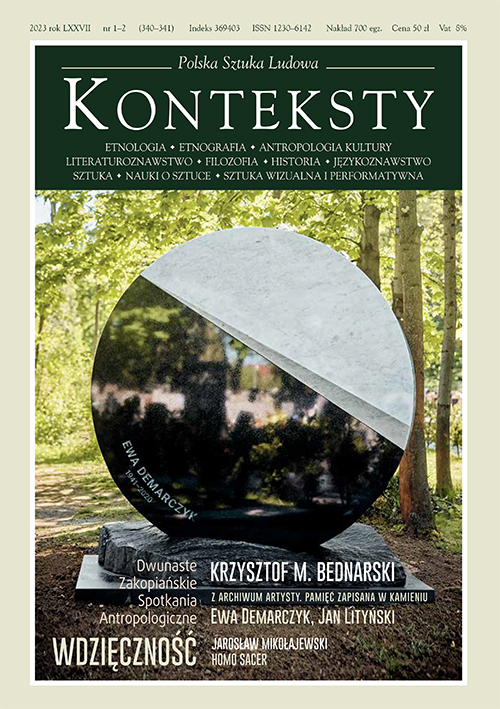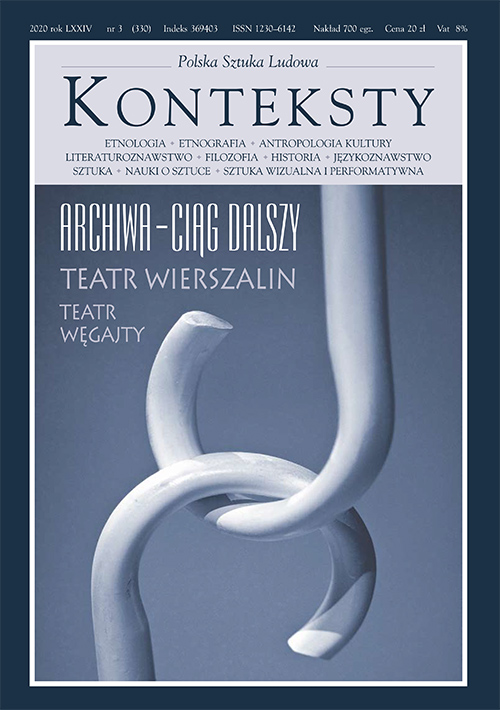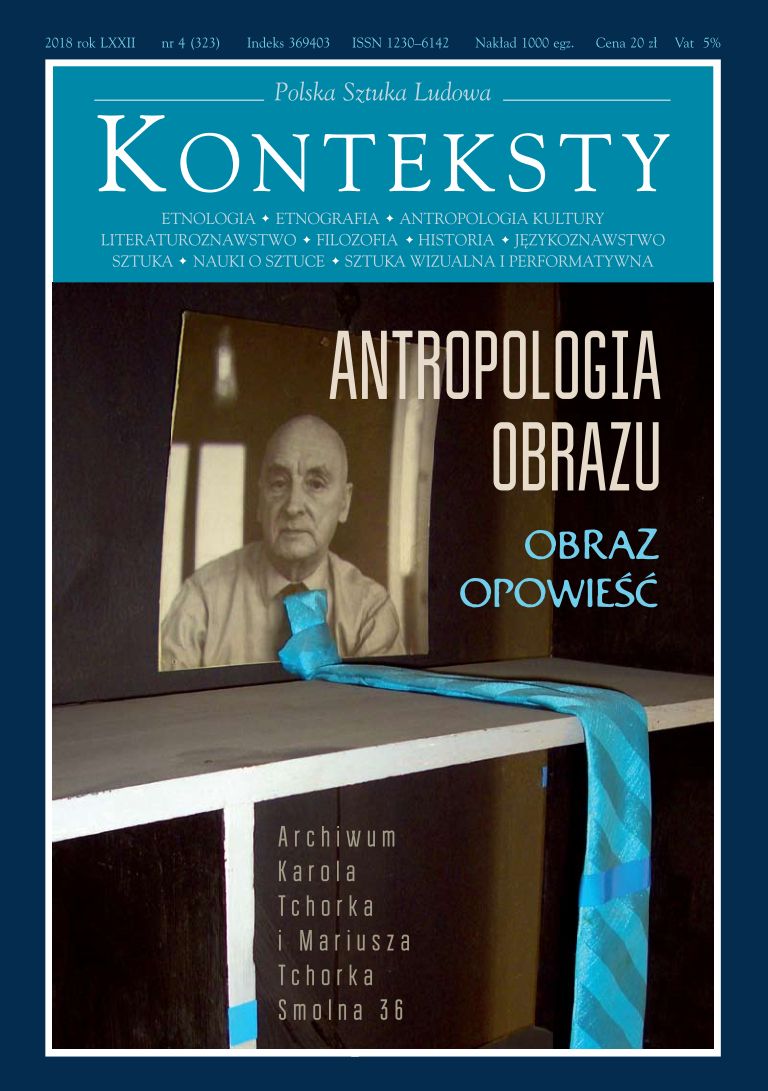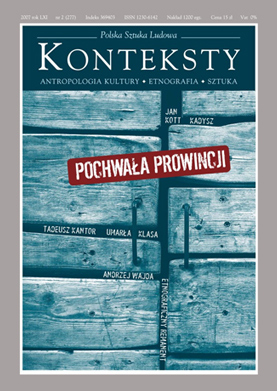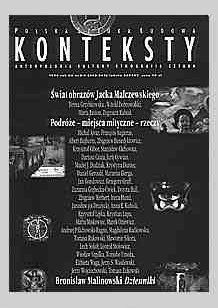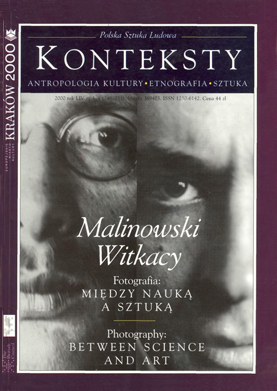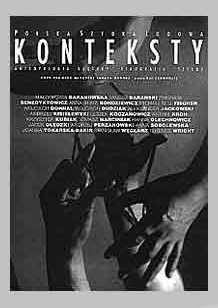Issue 2019/4 (327) - Lucim 111 / Organicity and the Avant-garde

| 40 years of Lucim 111 Group | ||
| Katarzyna Sędek | Year in the Life of Lucim  | 4 |
Account of making the film Rok polski / Polish Year (1992). The domain of interest was Lucim (a village in the Bory Tucholskie forest complex), the subject matter – the imagination of authors involved in works / activities, the manner of realisation – drawing the villagers into a joint experience, and the purpose – protest against spiritual and material poverty. | ||
| Olga Kwiatkowska | Memory Collage – an Image of Artists from the Perspective of the Local Community of Lucim  | 6 |
A presentation of the way in which the artists of Grupa 111 / Group 111 and their undertakings realised in the village of Lucim were perceived by the local inhabitants. The text was written upon the basis of fieldwork performed by the author in Lucim in 2003–2005. The joint activity of the artists conducted in this village was part of the past; hence the explorations studied the memory of the residents of Lucim, together with all the consequences. The image of the artists as seen by of the local community proved to be composite and multi-dimensional. The activity pursued by Grupa 111 certainly denoted direct contact with an entirely new sort of cultural practices, but both the degree of participation and involvement in ventures animated by the artists, and their assessment, were diverse. | ||
| Agnieszka Wołodźko | Grupa 111 against the Backdrop of the Counter-cultural Participation Paradigm and Its Present-day Topicality  | 12 |
The author of the text took a close look at the undertakings of Grupa 111 from the viewpoint of the counter-culture movement, which took place in Western Europe from the end of the 1960s. In doing so, she focused in particular on the activity of Scandinavian artists, very similar to that taking place in Lucim. Furthermore, she indicated the way in which the ideas of Grupa Działania preceded by several decades the new paradigm of art associated with the participation of the public in the creative process. Finally, Agnieszka Wołodźko accentuated the precursory character of activities pursued in Lucim in relation to the current priorities of the cultural policy of the European Union, postulating participation in culture and an expanded inclusion of recipients. | ||
| Katarzyna Niziołek | Echoes of Lucim. The Idea of Social Art and Contemporary Socio-artistic Practices  | 17 |
In this text social art, previously explored both by such artists as members of Grupa Działania in Poland, Joseph Beuys in Germany, or Suzanne Lacy in the United States, as well as sociologists, e.g. – perhaps most famously – Pierre Bourdieu in France, is defined as an enclave of civil society. As such, it can be distinguished by five interrelated characteristics: the public objective of activity and its broad range of addressees, the inclusive way the addressees are engaged in such activity – as creators or recipients of art, the social location of activity – outside both the art world and public cultural institutions, and the civic qualities of activity. This theoretical framework (a sensitizing concept) of social art is juxtaposed with thirteen empirical types of corresponding contemporary socio-artistic practices (participatory, interventionist, cooperative, collective, amateur, etc.), which “echo”, metaphorically speaking, the ideal developed by their predecessors in the 1970s–1990s. | ||
| Izabela Kowalczyk | Grupa Działania and Contextualism  | 24 |
The article examines the creative undertakings of Grupa Działania in reference to the theory proposed in Sztuka jako sztuka kontekstualna by Jan Świdziński as well as the latter’s efforts, among which Izabela Kowalczyk perceived numerous instances of a common ground. The author is also interested in differences in the approach to the œuvre of the discussed artists and compared the activity of Grupa from Lucim and Świdziński’s key term, i.e. the context. Moreover, she indicated the significance of nomadism both for Grupa Działania and Świdziński. The successive joint question involves interest in local cultures and the artist’s acceptance of the role of the ethnographer. Finally, the article formulates a thesis claiming that the presented artists proposed a “third way” in art by following the example of Joseph Beuys. | ||
| Monika Weychert | Invisibility or Escapology? Towards the Exploitation of Lucim  | 30 |
The author indicates reasons for the inconspicuousness of Grupa Działania / Grupa 111 in the art critique of the past, and today – in the history of art. The article describes the precursory undertakings of artists active in Lucim within the context of “usership” conceived by Stephen Wright, which indicates the possibility of “putting art to use” and proposes a lexicon of revived concepts referring to the slightly forgotten or abandoned instruments of the avant-garde. | ||
| Bogdan Chmielewski | Texts | 39 |
| Hanna Strychalska | „Zawiniątko” and Other Realisations. A Word about the Oeuvre of Bogdan Chmielewski  | 43 |
The author of this text analysed selected work by Professor Bogdan Chmielewski, and in particular the titular Zawiniątko, which due to its form and contents is depicted as characteristic for the mature period of the artist’s oeuvre. Chmielewski is also portrayed as the cofounder and representative of Grupa 111 Lucim. At the same time, his expressive and individualised realisations are a symptom of features shared by other members of Grupa 111, i.e. professors Witold Chmielewski and Wiesław Smużny, and in the past by Stanisław Wasilewski and Andrzej Maziec. The Professor’s objects, installations, drawings, art documentation, and para-theatrical performances, supplemented by his declarations as well as brief poetic texts, which constitute a commentary of sorts, are both inspirational and suffused with inner contents. The oeuvre of Bogdan Chmielewski refers to tradition, symbols, and universal values significant both for art conceived as a domain of life created by man and for consciously and, to a certain degree, naturally experienced daily life. | ||
| Hubert Czachowski | The Phenomenology of Lucim  | 51 |
An analysis of the significance of two scientific publications issued in Poland during the 1970s for the shape and development of artistic undertakings pursued in Lucim by Bogdan and Witold Chmielewski and Wiesław Smużny. The works in question are Gaston Bachelard’s Wyobraźnia poetycka / On Poetic Imagination and Reverie and Mircea Eliade’s Sacrum – mit – historia. Both authors are associated with phenomenology, but in each case this specific phenomenology is distant from the Husserlian original. The publications’ expansive and wide formula invited to pose questions addressed both to one’s cogito and to surrounding reality. In doing so they dealt with problems essential from the epistemological and ontological points of view, all the way to the ethical one. From those capacious and erudite thoughts artists active in Lucim derived their conceptions of the creation and impact of art. The categories devised by Eliade comprised a sui generis core of their quests, supplemented by the Bachelardian vision. The artists in question claimed that the sole path towards creating new social art is a proposal of disclosing and reinforcing old values, but also a search for new symbols and images, familiar and lucid to the Lucim artists. In their case this path – having read Eliade’s publications – was folk culture conceived as an ultimate, durable, and universal value due to its references to archetypes and fundamental symbols: fire, earth, water, air, and space, i.e. categories subjected to Bachelardian meticulous analysis. At the meeting point of those two conceptions they created their own vision of phenomenology and reached, upon the basis of the archetypes of folk culture, new domains of experience, both their own and that of the inhabitants of Lucim. | ||
| Karolina Leśnik | Thanks | 56 |
| Stanisław Wasilewski, Wiesław Smużny, Andrzej Maziec, Witold Chmielewski, Bogdan Chmielewski | Social Art as an Idea  | 57 |
The programme of social art, formulated by Grupa Działania in March 1980, was presented in 11 points preceded by the following introduction: “The social attitude involves the creation of an interpersonal link within the framework of social communication, appearing in direct contact between recipients and senders and the occasionally occurring changeability of the social roles of the two. It is possible to conceive work-activity, whose impact upon a selected local community will inspire the latter to embark upon own, individual and group creations, both symbolic and instrumental. This conveyance stimulus and its expanding-modifying reception resonance, treated jointly as a supra-individual and supra-auteur creation achieved within a community, could constitute a proposal addressed to art, i.e. a proposal of social art”. | ||
| Krzysztof Kopka | Poplars in Lucim – fragments  | 58 |
The fact that numerous authors of counterculture succumbed to the utopian approach (which is always a form of ideological thinking) resulted in a departure from the conception of the artist’s role and place proclaimed by them. In praxis the artist became a teacher instead of an interlocutor. And instead of being a member of a community he now claimed to be its leader, confessor, and judge. Amidst all Polish alternative cultures the Lucim-based Grupa Działania was among the few, which avoided entering this path (one that I regard as dubious) and remained faithful to professed ideals formulated in the Sztuka społeczna jako idea manifesto. It must be stressed that the choice of a small village as the site of Grupa’s activity was inspired by motives totally different from the analogous choice made by Gardzienice. Members of the Lucim group were not concerned with a virginal spot uncontaminated by a leprous industrial civilisation or with pure “springs of the theatre, art, and culture”. Contrary to Grotowski, Brook, Barba, Staniewski, and many others, they did not seek such a spot because they did not believe in the possibility of finding it. In a manifesto issued under the distinctive title: Zatrzymać się w miejscu they commented on such quests for the founts of “the water of life”: “For people living here, Lucim is the site of their family homes, roots, cultural tradition, and origins. Some founts have already dried up, others are merely buried, but still others continue producing rapidly flowing water. By no means pure and uncontaminated, this water is full of dirt, soil, and residues, it reeks of manure and does not lack blood, sweat and tears. BUT THIS TOO IS WATER”. The achievement of counterculture involved noticing a certain ambiguity associated with the traditional model of socially engagée art and the creation of an alternative model based on the following conviction: “If culture is to be genuine it must be the effect of what we are currently doing in order to live, and not something added to life like a sugar cube”. | ||
| Wiesław Smużny | Grupa 111  | 60 |
Grupa is associated with Lucim and is thus known as Grupa Lucim. Its logo features the following combinations: Lucim Grupa 111 or Lucim 111 Group. For the purpose of a brief and synthetic self-description within an art configuration the artists accepted digital identification: 111 – three or a hundred and eleven ones, a magic number in its visual spell, and a symbolic number. Instead of listing the authors: Bogdan Chmielewski, Witold Chmielewski, and Wiesław Smużny it suffices to say: Grupa Jeden Jeden Jeden / Group One One One. And instead of listing an even larger group of co-authors from Lucim one can say: Grupa Sto Jedenaście / the Hundred and Eleven Group. 111 should be read as: three ones, a hundred and eleven, and, additionally, as the jointly linked and simultaneous activity of social art concurrent with the idea of the artwork. The ones in 111 denote both the three authors working outside and, simultaneously, within a community environment, as well as the co-authors of activity conducted for the sake of their milieu and beyond it, e.g. for the world of art. | ||
| Wiesław Smużny | On the Margin of the Programme Slogans of Social Art after Eight Years of Implementing the Pro-social Artistic Stand  | 61 |
The task of defining the idea of “social art” was by no means easy. It could be said that “it stuck in one’s throat” within the context of the experienced mockery of the concept of ”social” in a reality whose system was supposedly established for, and focused on, the realisation of a social idea. Members of Grupa did not follow any sort of systemic pattern. Interest in the social reflection (expressed in reception) of our work was a binding motif of joint activity within Grupa Działania. After eight years of social-artistic activity in Lucim – from the time of the announcement of the idea and programme, or rather the currents of activity focused on implementing social art – and in the wake of years of creative activity encumbered with social tasks, it could be said in all modesty that works-activity in Lucim were, and are part of reality and not merely a theoretically and artistically imaginary fiction. From the perspective of practising social art we can demonstrate the topicality of its programme slogans by means of a recollection-repetition and an enhancing expansion of the remarks, clarifications, and reflections that come to mind. | ||
| Wiesław Smużny | Extract of Lucim  | 64 |
Wyciąg z Lucimia / Extract of Lucim indicates our 12 years long work in a local community. The exhibition, consisting of selected reconstructions and modest grey photographs – photo-fragments of our activity – arranged as if within a magic circle of time and place, calls for focused and friendly examination. It also requires the sort of attention we pay to old family albums. A kindly and absorbed examination of the display might make it possible to approach the idea and character of artistic endeavours pursued amongst members of a rural community. Photographs and slides are, as a rule, the sole visual materialisation of fleeting behaviour, ephemeral campaigns and activities as well as symbolic, special occasion, and fragile objects. We achieved, and continue to do so, that, which nine years ago we imagined and conceived to be social art – an idea, a target, and a programme of artistic conduct so different from the one proposed by art of the 1970s and the artistic configuration in which we grew up. Lucim is a practical, local laboratory of a pro-social artistic attitude. More, it is one of the Isles of the Blessed in the archipelago of art and… life. | ||
| Witold Chmielewski, Bogdan Chmielewski, Wiesław Smużny | Grupa 111. 52 Years in Lucim and the 42nd Anniversary of Initiating Akcja Lucim  | 67 |
Earliest beginnings (1967–1976) involved annual summer-vacation experiences of forests and lakes in the environs of Lucim; occasional and external contacts with the village. In 1975 Bogdan and Witold Chmielewski purchased an abandoned farm at the edge of a forest in Lucim-Kadzionka. The idea of “Akcja Lucim” envisaged as a year-long art-propagation experiment held in Lucim was conceived in the summer of 1977, after the completion of the “Akcja Podróż” project. The first meeting with the villagers took place at the local school on 26 October 1977. Frequent stays of members of the group in the village in the winter of 1977 and the spring of 1978 inspired final realisations. The finale of “Akcja Lucim”, held in the centre of the village on 19–20 August 1978, was a two-day celebration of art including numerous auteur presentations. Second stage – „Działanie w Lucimiu” (1978–1980). On the day following the finale of “Akcja”, i.e. 21 August 1978, it was decided to continue “Akcja” for years to come. In November the group (Wiesław Smużny, Bogdan Chmielewski, Stanisław Wasilewski, Witold Chmielewski, and Andrzej Maziec) adopted the name: Grupa Działania. 18 and 19 August 1978 – finale of the year-long Działanie w Lucimiu. Modification of activity from a one-time annual event into a repeated undertaking designated by the rhythm of the seasons: “Rocznica” (Anniversary) on 3 February, “Wiosna” (Spring) in March, “Lato – Święty Jan” (Summer – St. John’s) in June, „Świętowanie sztuki” (Celebrating art) in August, “Jesień – świętowanie plonów” (Autumn – harvest festival) in September, and “Zima – Święty wieczór” (Winter – holy eve) in December. In March – formulation of the “Sztuka społeczna” idea and programme. In May – establishment of premises for the Centre for Socio-artistic Activity (Ośrodek Działań Społeczno-Artystycznych) in Lucim; in August – inauguration of activity in the village common-room. Introduction of the idea of building a Community Centre in Lucim. Third stage – „Działania lucimskie” (1981–2019). Continuation, development, and modification of the model of socio-artistic activity in Lucim. Practical implementation of the idea of social art. 1981 – break up of Grupa Działania; Stanisław Wasilewski and Andrzej Maziec resign from activity in Lucim. 1982 – formulation of the idea of “New folk art”. Spring 1983 – initiation of building the Lucim Community Centre. Successive new ideas: “Trzecia droga” (1987) and “Podsacrum” (1989). Commencement of new meetings-festivities connected with the rhythm of Nature and the Church calendar. Inauguration of the Lucim ritual year with permanent and moveable meeting-festivities: „Święty wieczór”, “Rocznica 3 lutego” (Anniversary of 3 February), “Popioły” (Ashes), “Wielka Moc” (Great might), “Zielone” (Green week), “Wianki – Święty Jan” (Wreaths – St. John’s), “Lucim żyje!” (Lucim lives!), “Świętowanie plonów – dożynki” (Harvest festivities), „Szara godzina” (Eventide), “Za duchy” (All Souls) and “Domowiny”. In May 1989 members of the group assumed the name: Grupa 111. In 1989 – the establishment in Lucim of a Polish Branch of the European Council for the Village and Small Town ECOVAST, attended by the President of ECOVAST Michael Dover. 1991 – completion of the construction of the Community Centre. Dr Henning Albrechtsen, President of Telecottages International (TCI), paid several visits in Lucim. Onset of the idea of localising the first Polish telechata (telecottage – a local tele-information, education, and culture centre) at the Lucim Community Centre, and after its expansion – the establishment of a European Community Centre. Unfortunately, these projects were greatly ahead of their times; we also did not receive European Union financial assistance. Continuation of several-years long cooperation between Grupa 111 and the residents of Lucim with students from the Department of the Sociology of Rural Areas at the Nicolaus Copernicus University in Toruń and students and professors from Paderborn University (Fakultät für Naturwissenschaften) in Germany. In 1997 Witold Chmielewski resigned from further participation in the activity of Grupa 111; Wiesław Smużny and Bogdan Chmielewski still continue their cooperation with the villagers. | ||
| Witold Chmielewski | About Lucim  | 69 |
The present-day village of Lucim, with a population of ca. 550, is situated in the commune of Koronowo in the Kuyavian-Pomeranian voivodeship. In 1303 Lucim was purchased by the Cistercians of Byszewo, and on 3 February 1359, while in Żnin, King Kazimierz the Great granted the village feudal tenure law. A great battle waged by the Polish Kingdom against the Teutonic Knights, known as the battle of Koronowo, took place on 10 October 1410 in the neighbouring village of Wilcze, a mere three kilometers from Lucim, ensuring the Polish-Lithuanian army final victory after the battle of Grunwald. In 1860 the population of Lucim totalled 574, including 196 Germans (Protestants), 370 Poles (Roman Catholics), and 18 Jews. In 1906 Polish school children from Mąkowarsko, Lucim, and other localities protested against a growing Germanisation campaign. On 5 August 1924 the President of the Republic of Poland Stanisław Wojciechowski paid a visit in Lucim. The German army seized Lucim on 2 September 1939, and Red Army detachments appeared in the village on 16 January 1945. | ||
| Witold Chmielewski | Sixth Dimension  | 70 |
The Greek concept of leitourgia signifies public service. It is impossible to describe present-day activity in Lucim as liturgy in the contemporary sense of the word. Nonetheless, its original (correct) meaning contains that unusual sort of public service, which we have been performing in Lucim for years and which we described successively as: social art, pro-social stand, new folk art, and third way. Although this is down-to-earth activity (which should be additionally described as: down-to-water, down-to-fire, and down-to-air, as well as: domestic and roadside), it soars and strives towards finding itself, if only for a moment, “between earth and heaven”. There comes to the fore a sub-sacrum of sorts, closer, after all, to pagan sacrality deeply embedded in Nature, the local community and its territory, families and homes – the Lucim oikumene – than in the canonical sacrum of a Church institution. | ||
| Witold Chmielewski | Third Way  | 71 |
Present-day rural culture is no longer the “Kolbergian”, nineteenth-century version. This is not to say, however, that its certain specificity is not alive. Culture from the end of the 1980s is composed of remnants of tradition as well as much that is new and comes from the outside. Upon numerous occasions we are dealing with a degeneration of the customs of old, a process that we just as frequently find terrifying, but this is precisely what the culture of the present-day village looks like. Without doubt, the residents of Lucim have been growing increasingly prosperous – a process accompanied by a decline and deterioration of local culture. Identification with one’s village and even family is declining. Life in a community and family life are noticeably succumbing to descralisation. Numerous festivities and customs linked with work on the land and life on a family farm are either vanishing or growing increasingly insignificant. Nevertheless, Polish folk culture, albeit impoverished, remains sacral. This is the sort of reality we encountered in 1977. Have we managed to change much? Lucim has awakened from its sluggish existence. Increasingly often we came across, and impatiently awaited further such meetings and events. Open proof of this arousal assumed the form of the Lucim Community Centre, at present being constructed by the entire village. Today, Lucim, so recently underappreciated by its residents, who sometimes even declared: “It would be best if Lucim was to be ploughed over”, is becoming a source of pride. First, however, we were compelled to stir the village, to extract it from its lethargic state, and then slowly and tenaciously to awaken and set free its vigour. At the time, Lucim was simply unable to achieve such a target on its own. An outsider had to appear and take on this role. Originally, we acted in the dark, more concerned with being an artist (as was the case at the time of “Akcja Lucim” in 1978) than a co-author of the new Lucim culture. 12 years spent working in Lucim was a period of numerous splendid experiences and much satisfaction, but also of just as many bitter failures and moments of weakness. In time, however, we gained more and more allies, and several years later – also devoted friends. Today, we outright miss each other. Creating, activity, motion, observation, anticipation, studying, testing, modification, resignation, renewal, convincing, improving, crisis and restoration of faith – those are the features of our activity. It is impossible to separate all those elements because they generate a cohesive and multi-dimensional structure. Furthermore, everything takes place within the living organism of the village, and with the participation of its inhabitants. Processes initiated by us in Lucim – not only artistic but also distinctly culture-creating and social ones – started to encompass the entire village. Slowly, there emerged a new local culture combining old traditions and contemporaneity: elements of mass culture and our proposals. Initiatives and works created by the population of Lucim came into being. This was already the onset of “new folk art” – alive, born in the village, and, as in the case of grafting trees, increasingly turning into a part of its tissue, and thus becoming a new and different form of the village’s existence. New folk art serves directly those who co-create it and remains amongst them. By developing and existing predominantly within the people it makes it possible for them to discover and define their identity and self-esteem. Just like regional folk culture of old it is also an alternative vis-à-vis every sort of official culture – in our case, the unified mass culture imposed by the state. At the same time, however, it is an alternative in relation to official Church culture. The village culture of Lucim decisively opposes the depressing vision of the “global village” proposed by McLuhan and remains manifestly local. Simultaneously, it is also universal. In 1984 the process of becoming aware of those truths inspired me to formulate the idea of “post culture” based on the experiences of social art and “new folk art”. Frequently, an as yet unidentified post culture is emerging already now, in front of our eyes. It is the consequence of recent increasingly vital counterculture, forming since the Renaissance. From the end of the 1960s counter-culture has been contesting culture and challenging its sense. Nonetheless, it was incapable of creating permanent values on its own, because it had lost most of its energy while undermining the poor substitutes created by culture: “the religion of science”, “the religion of politics”, and “the religion of art”. Post culture is not directed against culture and counterculture, nor is it situated beyond their range. It does not negate values but renders them indelible and creates new ones. It carefully chooses from the residues of culture and counterculture. It reaches for the roots – the all-embracing sacrum. This is a culture undergoing transformations, a culture of numerous resignations and humility. It is not a culture of great slogans and undertakings, but of ideas and activities ostensibly inconsequential and scattered. A spontaneous form of self-defence against the ultimate decline of the most precious values. It is not tantamount to an attractive disassembly of the old or a brilliant construction of the new but comprises a laborious clearing of rubble and reconstruction on preserved foundations. New edifices will rise – but we shall find their main outlines familiar. Seeing them will not come as the sort of shock we sense while looking at super-modern and mighty constructions but will produce relief and a feeling of security, the same that we experience when, after many years of haste and travels, we finally stand in front of our family home. Just as Daniel Bell predicted, this will be a culture of a turn towards the past and tradition, a revival of memory, a culture of settling accounts and restrictions. There will also take place a great renascence and progress of the family, which will enable every person, together with those closest to him, to reveal and realise his creative activity in all its forms. Furthermore, it will also permit to boldly create one’s distinctness and to build personal identity and self-esteem. The path leading towards post culture can be described as a “third way” between the sacred and the profane; at the same time, it is precisely along this way that the sacred, descending into daily life, encounters the latter’s defiled version, which wishes to reach the level of sanctity. A path running between the church and the public office, between the roadside shrine and the community centre. Simultaneously, it is neither one nor the other: it remains in between and both links and divides. Lucim is a mediaeval village whose centre is encircled by a country road. This is precisely our third way, into which the country road changes from year to year. In everyday time it remains an ordinary road serving the purposes of daily bustle, but during the holidays it “soars upwards” while assuming a festive, ceremonial character. | ||
| Witold Chmielewski | Lucim Calendars  | 78 |
From the onset of our presence in Lucim we attempted to reach the local residents so as to inform them about our undertakings and invite them to participate. We sought many ways of accomplishing this goal. First and foremost, we were compelled to resign from methods applied in a town: printing and hanging posters, or relying on the press, radio, and television, quite useless in this particular case. After all, we wished to reach exclusively a rural community of over 600 persons. Therefore, in the autumn and winter of 1977 we used handwritten posters displayed on an oak tree in the middle of the village to inform about the first meetings to be held at the local school. During the two days long “Akcja Lucim”, conducted in August, our presence was announced on meticulously prepared boards and canvases arranged on sites featuring our works in the village centre. Later, when we became more recognisable and made friends with the inhabitants of Lucim, new forms – circulars and Lucim calendars – appeared next to paper and canvas posters. Lucim still cultivated the memory of the kurenda (circular) – an old way of notifying inhabitants about a village meeting by using a piece of paper circulated by neighbours and the village elder from household to household. We restored this custom and created handwritten “Kurendy lucimskie”, which the kindly village elder, Kazimierz Gettka, distributed among the villagers. Autumn 1989 witnessed the introduction of an exceptional novelty: all calendars addressed exclusively to the residents of Lucim were to reach every home and family. In the past such calendars used in village houses were delivered by chimney sweeps and postmen or added to popular newspapers (as farmer’s calendars). We attached importance to the fact that they were displayed on walls on a year-round basis and apart from fulfilling the usual functions of a calendar as such they could provide information about past events and those planned for the current year. “Kalendarze lucimskie” were inspired by an inter-war school chronicle, which I saw in Lucim and which contained diverse information about events of countrywide and local importance, the latter taking place in Lucim and at the local school – from the point of view of the village all were equally important. Such a comprehension of reality confirmed our Eliadean conception of Lucim as the centre of the world. In 1980–1991 we printed 11 editions of “Kalendarze lucimskie”, each composed of about 120 issues (111 and several intended for the authors) – corresponding to the number of homes in Lucim. These samizdat publications were issued outside the range of censorship and official circulation. We placed black-and-white photographs on transparent foil, with subsequent under-drawings by Bogdan; upon occasions, they included symbolic drawings executed by him. Bohdan also added our local Lucim events to the days and months copied by us or else wrote all 365 days by hand (as in the case of calendars for 1990 and 1991). The calendars were copied by using the screen-printing technique, already available at the time, and were printed in home production conditions; we lacked literally everything and, it must be kept in mind, personally financed the entire venture. Sometimes the copies were unclear and had to be corrected by hand. The foil used for preparing the screen print was exposed by Andrzej Maziec in one of the military electronic works in Bydgoszcz, where he was employed as a photographer. This was an extremely hazardous situation, especially during the martial law period, but then perhaps “it’s always the darkest under the lighthouse”? Next, the calendars were printed in a photography studio belonging to Stanisław Wasilewski, located in Bydgoszcz in one of the courtyards in a working-class district known as Londynek – this out of the way site was particularly useful after the proclamation of martial law. In the freezing winter of 1980 we delivered the first “Kalendarz” ourselves, walking from home to home in the village centre and reaching farmsteads scattered amongst distant fields, up to two kilometres from Lucim. Subsequent editions were already distributed with the assistance of Kazimierz Gettka. The calendars were either offered to the villagers while they were paying taxes or the village elder delivered them on his own. The printing and distribution of the Lucim calendars disclose significant areas of artistic freedom and civic liberty openly experienced in the village. We worked during a rather special period: several years prior to the August events leading to the establishment of Solidarity (1977–1980), the Solidarity era (1980–1981), the martial law period (1981–1983), and years prior to the Round Table (1983–1989) and in its wake. Fortunately, we never experienced any clashes with the militia and censorship. It turned out that even if the Security Service (secret police) knew about our existence (quite possibly someone in Lucim passed on pertinent information) it concluded that a distant village and a few artists organising harvest festivals, Midsummer celebrations and village dances do not pose a threat to the socialist homeland. In Lucim we enjoyed unlimited freedom, both as regards dependence upon state institutions, the militia, and censorship, as well as taking into account the opinion of the Church, at the time favourably inclined towards artists, but by no means open to everything. We showed “Kalendarze lucimskie” at the exhibition Lucims 111, held at the BWA gallery in Bydgoszcz in the autumn of last year. Seen today, 30 and 40 years on, the calendars render us aware of their exceptional form and the function fulfilled at the time. After all, with their 12 months and 365 days they are the successors of Roman and Latin calendars as well as the Gregorian calendar used for almost 500 years. Nevertheless, they simultaneously linked their universum, binding in Europe and a large part of the world, with the locality of Lucim. On a wider scale, they are part of the essence of our efforts to connect the universum of the cosmos and Nature with pre-Christian and Catholic tradition as well as free thought and art. The outcome assumed the form of an initiation and an introduction, shared with the local inhabitants, of new events, customs, and holidays, which simply could not exist in this form in any other place in the world. Just like the calendars – they too are a unique phenomenon. The last calendar was printed in 1991 – in this natural way the need for making them came to an end. The dissemination of photocopiers made it easier to duplicate the invitations which Bogdan prepared (wrote and drew) for each event. At that time, we benefitted from the kindness of the postman who distributed them together with the mail. In addition, extremely colourful and attractive wall calendars, produced on a mass-scale, made their appearance. | ||
| Wiesław Theiss | Place – Memory – Education the Perspective of Lucim and Węgrów  | 83 |
This retrospective analysis is conducted in a parallel (albeit not comparative) configuration of two art so-cial-educational programmes realised in Lucim (since 1977) and Węgrów (from 1987). The objective of the programmes involved the activisation of the local community around the local culture and tradition of the Polish village (Lucim) as well as the local history and social memory of a small town (Węgrów). The foundation of the presented analysis consists of selected conceptions of the comprehension of the locality (small homeland), local culture, “memory site”, and the pedagogy of memory as well as the premises of social (participatory) art and methods of social-cultural animation. The article discusses basic premises, goals, and selected forms of the “Lucim campaign” interpreted as a process of community education and the acculturation of the local community. The same perspective was applied for presenting selected forms of the implementation of the “Węgrów programme”, with emphasis put on the place and role of local memory in shaping civic stands and social involvement. The presented text is a contribution to the problem of socially engagée art as well as the theory and praxis of community education and the pedagogy of memory. | ||
| Wojciech Luchowski | Lucim 111 – a Sheer Delight!  | 94 |
The exhibition: Lucim 111, held at the turn of September 2018 at the bwa Municipal Art Gallery in Bydgoszcz, marked the 40th anniversary of Akcja Lucim – an artistic and social experiment initiated by Grupa Działania, subsequently transformed into Grupa 111. The presented text is an auteur commentary-reflection pertaining to this event, written from the viewpoint of the author and designer of the exposition. How is one to show and describe this artistic-social phenomenon? Here, the most essential appears to be the ideological dimension, whose manifestation is Sztuka społeczna jako idea – a programme written by the artists in March 1980 and constituting both a point of reference and a question concerning the topicality of this particular manner of thinking and acting. A visual equivalent of the above question was the exposition as such, which assumed the form of a board game encompassing the entire display and putting it into order together with the architecture of the gallery. The most essential paths of the experiences of Grupa 111 were inserted into the thus envisaged space (situation). | ||
| Witold Chmielewski | Mrs Maria’s Poems | 97 |
| Danuta Benedyktowicz | Grupa Lucim 111 in several contexts and in „Konteksty”  | 101 |
Presentation of documentation and articles pertaining to Grupa 111 in “Konteksty” (1985–2019). Grupa Lucim 111 is one of the best documented and significant artistic phenomena considered and interpreted in “Konteksty”. The author portrays this presence in various contexts and in the vicinity of problems and phenomena discussed in particular issues of the quarterly. | ||
| Organicity and the Avant-garde | ||
| Agnieszka Rejniak-Majewska | Organicity and the Avant-garde. Introduction | 118 |
| Johann Wolfgang Von Goethe | Metamorphosis of Plants fragments | 120 |
| Charlotte Douglas | Evolution and the Biological Metaphor in Modern Russian Art  | 122 |
A particular feature which distinguished modern Russian art from the parallel western developments was its attachment to organic aesthetic. The organic interests of artists such as Kandinsky and Tatlin became obvious in the 1920s, but these were only the later surfacings of a structure that deeply informed very early modernist theory and that was as applicable to poetry as it was to visual arts. In its organic, evolutionary vision of the world the Russian avant-garde drew on a great variety of sources: Goethe’s morphological theories, Romantic philosophy of nature, bergsonian vitalism, Lamarck’s transformationism, and the dissemination of Darwin’s theory of evolution. As the author argues, the vision of a world in continuous evolution was responsible for the rejection of conventional representation and for a shift in the focus in art from the end result – a completed picture of a static object – to the object in flux and the very process of making the work of art. | ||
| Oliver Botar | László Moholy-Nagy and Biocentrism  | 136 |
László Moholy-Nagy is well-known for his appreciation of technology and the use of technical media as new means of artistic creation. Less attention was given to the holistic and vitalist ideas expressed in his writings and pedagogical practice at the Bauhaus. The text proposes a contextual reading of the artist’s conceptions, tracing his engagement in Lebensreform movement – the modernist movement of the “organic” reform of live, and his connections with Raoul Heinrich Francé, the Austro-Hungarian biologist and popular scientific writer, who argued for the „organic” development of technology. | ||
| László Moholy-Nagy | The New Vision: From Material to Architecture Fragments | 144 |
| Walter Benjamin | News from Flowers | 146 |
| Agnieszka Rejniak-Majewska | Nature Means Plasticity. Microphotography and Abstract Art  | 148 |
The text discusses the use of microphotography in art publications in the early decades of the twentieth century and the parallels established between microphotography and abstract art. As the author argues, the photographic trend of “New Vision” contributed to the growing presence of microphotography in the popular visual culture of the time, but artists’ concern preceded this popularity. Microphotography brought interest both as a manifestation of an invisible, hidden reality, and for purely aesthetic reasons, as a source of infinite variety of decorative patterns. For artists like Klee and Kandinsky scientific images proved instructive with regard to the elementary structures of design and formative forces of living organisms. Viewed in light of the Monist philosophy of Haeckel, Driesch and Francé, microscopic images were recognized as a demonstration of the infinite plasticity of matter – a document of nature’s universal creative potential that art searched to parallel. | ||
| Aleksandra Jach | Organicity, Pathos and Plasticity of Emotions in Sergei Eisenstein’s “Nonindifferent Nature”  | 156 |
The text discusses Sergei Eisenstein’s publication Nonindifferent Nature. The author focuses on the notions of organic unity, pathos and plasticity of emotions that form the skeleton of Eisenstein’s concept of “art as a sensitive seismograph”. The “embodied” interpretation of art psychology proposed by Eisenstein results directly from his interest in natural sciences. In this context, Nonindifferent Nature is an interesting reference point for contemporary debates in the field of environmental humanities. | ||
| Spyros Papapetros | On the Biology of the Inorganic: Crystallography and Discourses of Latent Life in the Art and Architectural Historiography of the Early Twentieth Century  | 162 |
The text discusses the intersections between the natural sciences investigating the latent energy of the inorganic matter and the art historical studies of such authors as Alois Riegl, Wilhelm Worringer and Aby Warburg. The author reconstructs the discourses of Monist natural philosophy concerning the inner animation of plants, crystals and minerals, especially “biocrystals” and “liquid crystals”, as the newly discovered entities on the verge of organic and inorganic. These scientific explorations and the notion of inorganic animation stirred the imagination of art historians. The concept of inorganic animation was adopted by Wilhelm Worringer in his theory of ornamental styles proposed in his book Abstraction and Empathy: A Contribution to the Psychology of Style (1907). The impact of Monist philosophy is also traceable in Aby Warburg’s conception of art history, in his notion of Pathosformel (pathos formula) understood as a form of static animation, as well as in his conception of the latent posthumous life of images. | ||
| Rozalia Słodczyk | Plastic Rhythm and the “Hidden Mathematics” of Perception. The Case of Italian Futurist Painting  | 176 |
The theory and works of the Futurists are characterized by fascination with movement, the dynamism of things and the surrounding reality. Futurists’ interest in the notion of energy gave a privileged place in their works to visual rhythm. Rhythmic repetition of dissected forms not only allowed to suggest the motion of represented objects, but the abstracted, repetitive patterns created a rhythmic pulsation directly perceived by the viewer. The rhythm of the painting, created by rhythmic vibration and pulsation of shapes and colors, was to give intimation of the universal vibration and interpenetration of matter. | ||
| Włodzimierz Lengauer | Walter W. Otto, the Greek Gods and Eleusis  | 186 |
Walter Friedrich Otto (1874–1958) was one of the most outstanding representatives of German twentieth-century Altertumswissenschaft. Moreover, he played a prominent part in entire German culture of the period as an impressive humanist deeply convinced about the significance of Greek culture for modern European culture as a whole and, in particular, for German humanism. His theoretical interests in religious beliefs were enrooted in the philosophy of Friedrich Nietzsche and close to Martin Heidegger. Otto embarked upon his scientific path by pursuing Latin studies and linguistics; previously, he studied Roman and, subsequently, Greek religions, perceiving the latter as a supreme achievement of religious thought, and claiming that the foundation of Greek polytheism was a religious attitude toward Being (das Sein), which he contrasted with Christianity. In doing so he considered himself to be a polytheist and a pantheist, in the manner of Goethe. German experts on classical culture for long treated Otto’s interpretations sceptically or outright grudgingly, and Martin Nilsson, regarded as a great authority, harshly assessed his Dionysus (first edition: 1933), today recognised as a classic. In contrast to Nilsson, Otto’s interpretation of Greek religion emphasised intense and authentic religious experience, which became the substance of the “vision” (das Schauen) of the believer. Cooperation with the acclaimed ERANOS group produced Otto’s brilliant study: Der Sinn der eleusinischen Mysterien (its English translation: The Meaning of Eleusinian Mysteries, was published in 1955), to this day extremely important for all dealing with this range of problems owing to the fact that it drew attention to the significance of religious experience in rites celebrated in the Eleusian telesterion. Today, Walter F. Otto is acknowledged as one of the “great four” of twentieth-century classical scholars dealing with Greek religion, on par with Károly Kerény, Jean-Pierre Vernant, and Walter Burkert. Familiarity with his conceptions, entire oeuvre, and specially, apart from Dionysus, his book: Die Götter Griechenlands, is absolutely indispensable for those wishing to earnestly study the religion of the ancient Greeks. | ||
| Walter Friedrich Otto | The Meaning of the Eleusinian Mysteries | 192 |
| Wojciech Bałus | Touching with Sight. On the Concept of Haptic Perception in Classical Art Studies  | 202 |
The concept of haptic perception appeared in art studies in about 1900 when the history of art embarked upon the construction of its specificity by creating the theoretical foundations of applied methodology. Concentrated on formal questions, it perceived the essence of research in stylistic ascertainment. By seeking adequate instruments for capturing the phenomenon of the visible form of an artwork in linguistic categories researchers of the period turned their attention to Adolf von Hildebrand’s Das Problem der Form in der bildenden Kunst (Problem of Form in Painting and Sculpture), from which they borrowed the distinction between seeing (Sehen) and scanning / looking at (Schauen). Schauen was associated with the movement of the eyeballs and resembled the function fulfilled by the sense of touch: when the onlooker followed the contour of an object he performed something analogous to running a finger over the edge of that object, and when he gazed at a surface he acted in the fashion of someone who touches an object with his whole hand. This distinction was applied in conceptions introduced by Alois Riegl, Heinrich Wölfflin, and Bernard Berenson, who preferred the sense of sight as the source of the perception of artistic phenomena. In their theories touch fulfilled an auxiliary function and, according to their opinions, it corresponded, on the one hand, to the early stages in the development of man, when the process of becoming acquainted with reality calls for motion and physical contact with the objects surrounding us; on the other hand, touch was indispensable for a metaphorical definition of a certain type of perception or devising a visual arts form. Using sight alone, not only without resorting to hands but also in a dual manner – first in an optic modus and then in a haptic one – was, therefore, an expression of civilizational maturity. Contemporary studies from the domains of psychology and neurophysiology indicate that the elimination of haptic experiences from the processes of creating and receiving an image is impossible upon every stage in the life of an individual and entire societies. This means that Hildebrand, Riegl, Wölfflin and Berenson as well as the psychologists and philosophers up whom they based themselves intentionally rejected the appreciation of touch and a priori assumed the dominating role of the sense of sight, although they must have been aware of the role played in life by kinesthesis and haptic impressions. The conception of art and corporeality, obligatory at the end of the nineteenth century, was responsible for the preference for sight and assumed a total disjunction of life and art. According to it, painting or sculpture had to use material which only due to processing and covering it with paint began to present a figure or a view. In art similarity was to be the outcome exclusively of the artist’s skill, capable of creating an illusion of naturalness with the assistance of paint or a chisel. The essence of thus comprehended art was Walter Benjamin’s “aura”. When did this conception cease to be obligatory? The symbolic onset of its erosion could be the year 1936, when The Work of Art in the Age of Mechanical Reproduction was written. This essay by Benjamin was by no means an apology of aura. On the contrary, it voiced a positive opinion about its fall in a world undergoing modernisation and attempted to indicate the symptoms and causes of this state of things. A significant symptom of the new epoch was the emancipation of haptic values. The division into art, life, and body became questioned. A true rapprochement of art and life did not take place until after World War II. First, it entailed the strategy of “disassembling” the traditional image by piercing it, undertaken by assorted artists, and, subsequently, by directly using the actual body of the artist as a medium that could be, i.a. touched. | ||
| Agnieszka Kosińska | “Keep thee well and charged!”. On Correspondence between the Czapskis and the Herberts. And Not Only  | 208 |
Essays analysing two most important relationships in the life of Józef Czapski: with his sister, Maria, and Ludwik Hering. Józef Czapski’s older sister Maria (1894–1981) was a confidante and friend, who shared his creative and independent life. Agnieszka Kosińska focused on the significant motifs of Maria’s biography and its fusion with the spiritual biography of Józef Czapski and his circle. “The correspondence between the Czapskis and the Herberts perfectly extracts both the form and essence of the life shared by Józef and Maria. A form that stirred the curiosity of so many: how was this phenomenon possible? Perhaps it involved something abnormal and unnatural? Some sort of a taboo, begging your pardon? Have we forgotten so easily just how many shades of closeness can actually take place in human space? How many forms can be assumed by agape, eros, caritas? Józef and Maria were linked not only by their parallel paths (but what came first? their childhood affection or shared trail?) from Prague to Przyłuki, St. Petersburg, Warsaw, Cracow and Paris, but also by a profound human and creative understanding, which, naturally, was associated with their lifestyle”. Ludwik Hering (1908–1984) was a painter, man of letters, author of conceptions, and director and stage designer of Teatr na Tarczyńskiej and Teatr Osobny. “Known as the leaven of artistic and intellectual life in Poland and not only” – wrote Ludmiła Murawska-Péju, his niece, painter, and editor of the Czapski–Hering correspondence. “Even if his letters to Czapski were to be the only remaining part of the entire Hering œuvre – Kosińska wrote – they would suffice. We are dealing not solely with a precious metal of sensitivity, a ‘hotchpot of reality’ (a term used by L.H.) and anguish, depicted in such perfect and accurate images, suspense and dialogues, but, first and foremost, with operating with silence. Who knows: quite possibly Hering was one of the very few men in Polish literature – although I cannot say who else there could have been – capable of applying Norwid’s art of passing over in silence, including typography and punctuation, in this fashion albeit in a totally individual, purely Heringian way”. | ||
| Agnieszka Kosińska | “The consistency of this state: there was no need to speak and name. I could forward my thoughts directly to you”. On the Czapski–Hering Correspondence  | 217 |
Essays analysing two most important relationships in the life of Józef Czapski: with his sister, Maria, and Ludwik Hering. Józef Czapski’s older sister Maria (1894–1981) was a confidante and friend, who shared his creative and independent life. Agnieszka Kosińska focused on the significant motifs of Maria’s biography and its fusion with the spiritual biography of Józef Czapski and his circle. “The correspondence between the Czapskis and the Herberts perfectly extracts both the form and essence of the life shared by Józef and Maria. A form that stirred the curiosity of so many: how was this phenomenon possible? Perhaps it involved something abnormal and unnatural? Some sort of a taboo, begging your pardon? Have we forgotten so easily just how many shades of closeness can actually take place in human space? How many forms can be assumed by agape, eros, caritas? Józef and Maria were linked not only by their parallel paths (but what came first? their childhood affection or shared trail?) from Prague to Przyłuki, St. Petersburg, Warsaw, Cracow and Paris, but also by a profound human and creative understanding, which, naturally, was associated with their lifestyle”. Ludwik Hering (1908–1984) was a painter, man of letters, author of conceptions, and director and stage designer of Teatr na Tarczyńskiej and Teatr Osobny. “Known as the leaven of artistic and intellectual life in Poland and not only” – wrote Ludmiła Murawska-Péju, his niece, painter, and editor of the Czapski–Hering correspondence. “Even if his letters to Czapski were to be the only remaining part of the entire Hering œuvre – Kosińska wrote – they would suffice. We are dealing not solely with a precious metal of sensitivity, a ‘hotchpot of reality’ (a term used by L.H.) and anguish, depicted in such perfect and accurate images, suspense and dialogues, but, first and foremost, with operating with silence. Who knows: quite possibly Hering was one of the very few men in Polish literature – although I cannot say who else there could have been – capable of applying Norwid’s art of passing over in silence, including typography and punctuation, in this fashion albeit in a totally individual, purely Heringian way”. | ||
| Magdalena Kasa | Correspondence between Hanna Nałkowska-Bickowa and Ludwik Hering 1948–1951. Introduction  | 220 |
A presentation of correspondence between Hanna Nałkowska-Bickowa and Ludwik Hering from 1948–1951, preceded by an introduction by Magdalena Kasa. | ||
| * | Correspondence between Hanna Nałkowska-Bickowa and Ludwik Hering 1948–1951 | 222 |
| Tomasz Gruszczyk | To Test Oneself by Reading. Józef Czapski’s Experience as a Reader  | 230 |
This sketch deals with Józef Czapski’s reading experiences and the persona of the reader contained in his texts. Selected essays and journal entries have been treated as textual protocols of a certain experience: the incessant process of becoming a reader vis-à-vis the text. The specific feature of the way in which Czapski read was its existential dimension – reading involves the author. By reading not only intellectually but also spiritually Czapski-the reader moved the texts from the constant addresses of the meanings ascribed to them and introduced them into life – he activated meanings and tested their value. In the same fashion he permitted the texts to lead him beyond the heretofore comprehension of his existence, beyond that, which exits, in order to discover, change or even to create himself. He tackled them, but also applied their measure to himself. The origins of a thus comprehended process of reading (i.e. as an experience or a trial) goes back to M. de Montaigne and his Essais – these affiliations too are followed in the article. | ||
| From the artist's archive | ||
| Krzysztof M. Bednarski | Curb – In Memory of Jan Szeliga | 239 |
| Krzysztof M. Bednarski | Incontro con Federico Fellini – Monument in Rimini | 242 |
| Hanna Podgórska | Non-professional Artists from the Aleksander Jackowski Archive – Władysław Sułowski  | 248 |
First article from a planned series presenting the outcome of the “Aleksander Jackowski research archive: folk artists and non-professional artists” project, financed by the Minister of Culture and National Heritage as part of the “Digital culture” programme realised in 2018 by the Liber pro Arte Society under the supervision of dr hab. Zbigniew Benedyktowicz, professor in the Institute of Art at the Polish Academy of Sciences. The author analysed documents connected with Władysław Sułowski (1926–1972), amateur painter from Nowa Huta, author of over 250 paintings featuring a captivating fairy-tale ambiance and colourful ornaments, as well as several score sculptures, partly inspired by the œuvre of Marian Kruczek. Numerous Sułowski’s works were purchased for his collection by Ludwig Zimmerer (1924–1987), expert on, and admirer of Polish folk art. | ||































